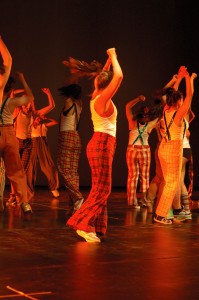by Janet Neidhardt

It’s amazing how influential music can be on the dancing body. Some sounds get the heart pumping and feet moving quickly while others lend the body to slow and meditative motions–and then there is everything in-between. As a dance educator, it is important to me that I educate my students about the relationship between music and dance.
Students can sometimes be resistant to music that is different than what they hear on the radio, so I have developed a system of creating openness to new music. I start the year off with music they might recognize for a warm up and then slowly start to bring in more ethnic music with strong beats. Then I introduce music that doesn’t have clear down beats and might be counted in 5’s or 7’s etc. This is a good challenge for students to count to and can also work well for phrases that might not have counts, where timing is more free form.
I like to play with music when teaching movement. I often have students perform movement phrases to various styles of music to compare and contrast how the music changes the feeling and emphasis within the movement. This kind of activity pushes students to think more deeply about movement and how it feels from the inside to dance as opposed to what they look like on the outside. For teenagers who tend to focus on what they look like a lot this can be an especially challenging and needed task.
When students are given a choreography assignment I often push them out of their comfort zone by only allowing music without words. They are able to explore the various interpretations of music and movement without the meanings that words can give within a song. Using music without words can provoke more creativity, wider range of movement possibilities, and open up ideas for relating movement to the music.
I spend a lot of time during the summer months searching for new and different music to use for the upcoming school year. (Songza is a great app to use with various playlists.) It is important to recognize how influential music is to the movement of our bodies and to our choreography. Since I have to choreograph about 4 pieces a year it is important that I find music that inspires my own creativity.
Whether it’s choosing music for teaching or choreography, thoughtful and intuitive choices are needed. Sometimes we need to wake up to Destiny’s Child and sometimes we need to improvise with Philip Glass–and sometimes it’s vise versa!
When I know the goal of a class I’m teaching, I find the music I need to play to help my students achieve that goal.
Do you have any tips for choosing/using music for students? Feel free to share!

Contributor Janet Neidhardt has been a dance educator for 10 years. She has taught modern, ballet, and jazz at various studios and schools on Chicago’s North Shore. She received her MA in Dance with an emphasis in Choreography from the University of North Carolina-Greensboro and her BA in Communications with a Dance Minor from the University of Wisconsin-Madison. Throughout her time in graduate school, Janet performed with Sidelong Dance Company based in Winston-Salem, NC.
Currently, Janet teaches dance at Loyola Academy High School in Wilmette, IL. She is the Director of Loyola Academy Dance Company B and the Brother Small Arts Guild, and choreographs for the Spring Dance Concert and school musical each year. Janet is very active within the Loyola Academy community leading student retreats and summer service trips. She regularly seeks out professional development opportunities to continue her own artistic growth. Recently, Janet performed with Keigwin and Company in the Chicago Dancing Festival 2012 and attended the Bates Dance Festival.
When she isn’t dancing, Janet enjoys teaching Pilates, practicing yoga, and running races around the city of Chicago.





